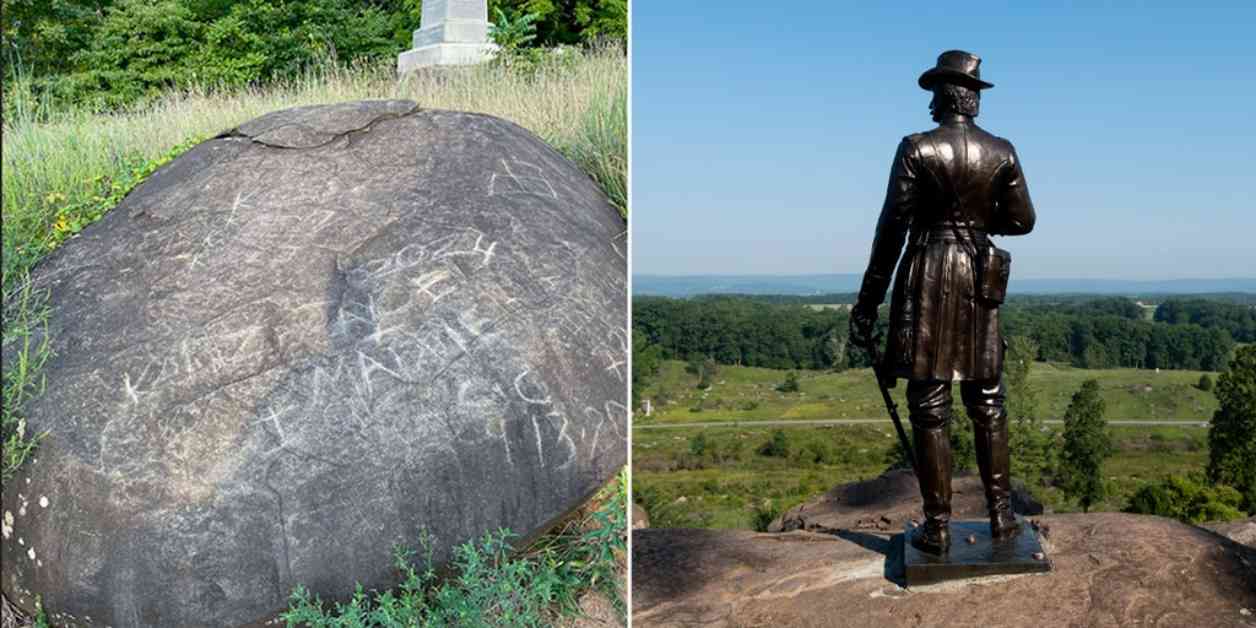Restoring Gettysburg Battlefield: Preservationists Remove Vandalism
Two incidents of vandalism have reportedly taken place at Gettysburg National Park within one week. On August 15, park officials reported that multiple boulders had been defaced with graffiti inscribed onto the faces of large stones on Little Round Top, the National Park Services (NPS) reported. The second incident took place on August 19, when visitors of the historic site reported that graffiti had been spray-painted on the historic War Department Observation Tower.
“Our hearts sank when these two cases of vandalism were reported within days of each other,” Kristina Heister, park superintendent, shared in an NPS press release. Park preservationists came to the rescue — and were able to remove all traces of the vandalism by August 20.
Restoration Efforts
The preservation staff at Gettysburg National Park worked tirelessly to restore the defaced boulders and the War Department Observation Tower. They expertly removed the graffiti, ensuring that visitors could continue to experience the historic sites as they were intended. Kristina Heister expressed her gratitude for the preservation staff, referring to them as the heroes of the hallowed ground.
Identification of Suspect
Police have been able to identify a suspect involved in the spray-painting at the historic military park, according to the Gettysburg Borough Police Department. The incident is still under investigation, and if found guilty, the subject may face up to six months in jail or be fined up to $5,000, the penalty for vandalizing a National Park, as stated by the NPS.
Historical Significance of Gettysburg
Gettysburg National Park holds immense historical significance, particularly during the Civil War. Little Round Top played a crucial role in the final stages of the war, with Medal of Honor recipient Joshua Lawrence Chamberlain leading a pivotal bayonet charge that helped secure Union victory. Vandalism of such historic sites is not only disheartening but also disrespectful to the sacrifices made by those who fought on the battlefield.
Community Responsibility
Jason Martz, Gettysburg National Military Park’s communication specialist, emphasized the importance of community responsibility in protecting and preserving historical sites like Gettysburg. He urged Americans to be stewards of the heritage, history, and resources of the park, highlighting the shared responsibility in safeguarding these irreplaceable treasures.
Reopening of Little Round Top
Little Round Top recently reopened to the public after undergoing nearly two years of rehabilitation. The reopening signifies the dedication to preserving and maintaining the historical integrity of the site, making it accessible once again for visitors to appreciate and learn from the events that took place on its grounds.
Police and Park Services Collaboration
Both the National Park Services and the Gettysburg Borough Police Department have been working closely to investigate the acts of vandalism and identify those responsible. Collaboration between law enforcement and park officials is essential in ensuring the protection of national treasures like Gettysburg National Park.
Challenges of Preservation
Preserving historical sites such as Gettysburg comes with its challenges, including the threat of vandalism and damage to structures and artifacts. The incidents of graffiti at the park serve as a reminder of the constant vigilance required to safeguard these important landmarks for future generations.
Impact of Vandalism
The defacement of boulders and structures at Gettysburg National Park not only tarnishes the physical appearance of the site but also disrespects the memory of those who fought and died there. Vandalism undermines the efforts of preservationists and the significance of the battlefield as a symbol of American history.
Education and Awareness
Increasing public awareness about the importance of preserving historical sites like Gettysburg is crucial in preventing acts of vandalism. Education initiatives and community outreach can help instill a sense of responsibility and respect for these national treasures.
Future Preservation Efforts
Moving forward, continued preservation efforts will be essential in maintaining the integrity of Gettysburg National Park. Enhanced security measures, community engagement, and educational programs can all contribute to safeguarding the battlefield and ensuring its historical significance is preserved for generations to come.
Conclusion
The recent incidents of vandalism at Gettysburg National Park serve as a stark reminder of the ongoing challenges faced in preserving historical sites. The swift action taken by park preservationists to remove the graffiti underscores the dedication to protecting these irreplaceable landmarks. Through collaboration between law enforcement, park officials, and the community, efforts to safeguard Gettysburg and other national treasures can be strengthened. It is imperative that we all take on the responsibility of being stewards of our history, ensuring that these sites remain intact for future generations to learn from and appreciate.




